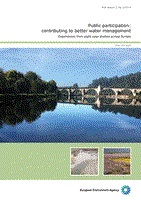
Rivers are home of many thousands of wildlife species, vital arteries for farmland, a source of cooling for industry, flood regulation, navigation channels and source of drinking water, to name just a few important functions. Such multiple demands on water bodies mean that many different groups need to be actively involved in managing a river basin.
Cover ImageThe best way to involve these groups is explored in ‘Public participation: contributing to better water management’, a report from the European Environment Agency (EEA). It examines how water basin managers have involved the public and groups of stakeholders in eight river basins across Europe, looking at ways public participation can improve water management.
The European Union’s Water Framework Directive states that all river basins in Europe should be managed using a River Basin Management Plan. The public should be involved in creating this plan, in addition to other established stakeholders including private companies, conservation organisations, farmers, utilities and local government.
The report recommends creating “an environment of accessibility, receptiveness and mutual respect”, boosting transparency and trust among participants. Such an atmosphere can improve the ‘buy-in’ of those involved in implementing water management policies, improving the success rate of water management policies.
The EEA report echoes Right2Water, the first successful European Citizen’s Initiative accepted by the European Commission in March this year. The initiative aims to ensure access to water and sanitation across the EU.
Key findings
- For a participatory process to be successful, the institutional set-up and processes need to be clear and transparent to all participants, the report says. A common understanding of responsibilities is also important, including an understanding of the institutions responsible for specific economic activities or geographical areas. Ultimately, participants need to know who they should address for particular aspects of the discussion.
- Various stakeholder groups need to feel that they have ownership of the water management plan. This improves the likelihood that they will fully implement the plans at a later stage.
- It is important to map the different groups with an interest in management of the river basin, the report finds. This can help to clarify what each stakeholder can bring to table in public participation, and help water managers tailor information accordingly.
- Practical activities involving stakeholders and the public seem to be the best way to increase trust and transparency in the participation process, the report notes. Face-to-face discussions are important. Trust is also increased by providing tangible evidence of how these discussions have influenced the development of the plan.
- Involving members of the general public appears to be more difficult than engaging with technical experts, so the report encourages river basin managers to improve communication, use modern communication methods and make technical explanations as clear and concrete as possible.
Source: EnvirocentreNews.ie – River Basin Management Relies on Effective Public Participation





